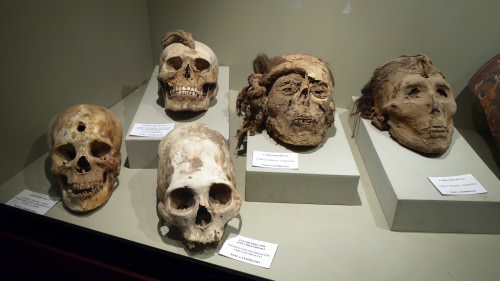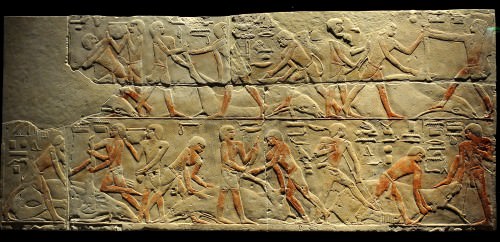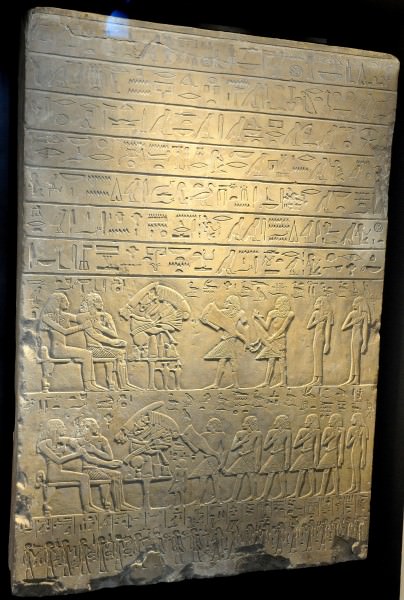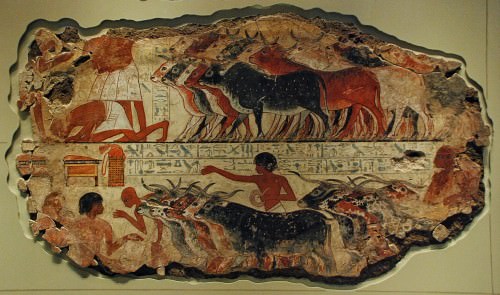Cahokia › Cahuachi › Ancient Egyptian Taxes & the Cattle Count » Origins and History
Articles and Definitions › Contents
- Cahokia › Origins
- Cahuachi › Origins
- Ancient Egyptian Taxes & the Cattle Count › Origins
Ancient civilizations › Historical places, and their characters
Cahokia › Origins
Definition and Origins

Cahokia refers to the location where Mississippian culture thrived before European explorers landed in the Americas. From about 700 CE to 1400 CE, this site flourished and was once one of the greatest cities in the world. The early Native American cultural hub once boasted a wide variety of edifices, including everything from monumental structures to basic homes for practical living. This complex society at Cahokia prospered in the fertile lands off of the Mississippi River (situated across the river from modern St. Louis, Missouri), and it was booming long before Europeans came to America.
The ruins of this sophisticated native civilization are preserved at Cahokia Mounds State Historic Site in Collinsville, Illinois.Within this 2,200-acre area, the remnants of ancient Cahokia are displayed, paying tribute to one of the largest and most influential urban settlements of Mississippian culture. The 3.5-square-mile park contains the ruins of approximately 80 mounds.However, at Cahokia's height, the site included more than 120 earthen mounds over an expanse of approximately six square miles.
Cahokia is considered a national historic landmark and is protected by the state of Illinois. It is currently believed to be the largest archaeological ruins north of Mexico's great pre-Columbian cities.
The fate of the Cahokian people and their once-impressive city is mysterious. The decline of this great civilization is believed to have been gradual. Most historians agree that the Cahokians began abandoning the city around the 1200s, and by 1400 CE the civilization was completely deserted. It is unknown why these people left or where they went. However, this site is significant to Chickasaw history because it is likely the place where many of the Chickasaw Nation's ancestors originated.
Cahuachi › Origins
Definition and Origins

Cahuachi, located on the southern coast of Peru, was the most important sacred site of the Nazca civilization. The Nazcaflourished between 200 BCE and 600 CE, and Cahuachi covers a similar time period. The site, which was used for harvest festivals, ancestor worship, and burials, is dominated by a series of huge ceremonial mounds and plazas. These have been a rich source of Nazca artefacts ranging from mummies to textiles, all well-preserved in the arid climate.
LOCATION & FUNCTION
In a particular spot of the southern Nazca Valley the Nazca River flows underground for a short stretch, and it was at this place, on the south bank, that Cahuachi was built. The water table here would have survived most droughts and so was considered a sacred place or huaca by the Nazca. The water was managed using underground aqueducts and cisterns with terraced entrances to irrigate the surrounding area and ensure a constant supply. The sacred nature of the site is further indicated by the high number of lines or geoglyphs on the surrounding desert floor. In another attempt to incorporate nature into their urban landscape the Nazca built huge mounds on top of a close grouping of around 40 hills. The site was linked to the other important Nazca centre Ventilla by a sacred road which crosses the San José desert.
TOMBS AT CAHUACHI CONTAIN MUMMIES BOTH OF VENERATED INDIVIDUALS WRAPPED IN FINE TEXTILES & SACRIFICIAL VICTIMS.
There is no archaeological evidence of a residential area at Cahuachi (refuse, plain pottery etc.), and pilgrims to the site probably stayed in tents for their brief visit. There are, though, some buildings which were probably used for storage or as workshops connected to the religious activities of the site. The presence of plazas suggests regular gatherings of a large number of people with the largest space measuring 47 x 75 metres. These plazas, in places, have holes and the remains of wooden posts suggesting large canopies were erected over them. The entire sacred area is enclosed by a 40 cm high wall.Cahuachi, then, was a site of pilgrimage, worship, and burial, and it eventually spread to cover over 150 ha.
BURIAL MOUNDS
The 40 burial mounds at Cahuachi were built using earth and adobe bricks. The earliest structures date to before 100 BCE while the latest were constructed c. 550 CE, consistent with the timeframe of the Nazca in general. Mounds were used as a place of burial for family or kin groups, with each mound containing the tombs of specific groups. This is a typical feature of the Nazca: shared cultural practices but carried out on an individual basis without any discernible influence from an integrated political power. In many Andean cultures ancestor worship was prevalent, and so we can imagine that pilgrims visited Cahuachi with that aim, regularly reopening tombs to add new mummies.

Ceremonial Plaza, Cahuachi
The largest mound, known as the 'Great Temple ' consists of six or seven terraces made from earth set on top of a natural hill and contained within adobe brick supporting walls. It reaches a height of 30 metres. Besides tombs in its interior, there are also small chambers in which were placed large numbers of clay panpipes, indicating music was an important part of Nazca ceremonies. The best-preserved tomb is at another mound and is referred to as the Room of Posts. It contains a central altar surrounded by columns supporting a roof. The walls are decorated with inscribed images of panpipes and faces with shining rays.
ARCHAEOLOGICAL FINDS
Although many of the tombs of Cahuachi have been looted, occasional finds of intact burials have revealed mummies wrapped in fine textiles. Some of these mummies - of men, women and children - show signs of being sacrificed. The individuals were Nazca people, not captured enemies for example, and they display such typical features of Andean burials as a perforated skull, removal of the tongue and placing it in a pouch, excrement in the mouth, and eyes and lips sealed using cactus spines.Some tombs contain evidence of animal sacrifice.

Mummy Skulls, Cahuachi
Other finds at the site include pottery, typically of finer quality than those for daily use, and painted with animals and hybrid human-animal figures, especially felines, monkeys, birds, lizards, and spiders with human faces. Textiles were often buried inside large ceramic jars. The images woven into or sometimes painted on the cloth show similar themes to the pottery decoration, along with scenes of bountiful harvests and agriculture. Many textiles have borders depicting staring human skulls.Two extraordinary finds are a single length of cloth measuring 7 metres by 60 metres and a store of 50 women's wrap dresses.These latter have images of hummingbirds very similar to those depicted in the famous Nazca lines geoglyphs across the nearby desert floor. Finally, in one specific area of Cahuachi, perhaps a workshop for weaving, excavations have found various instruments and tools used to make textiles such as spindles, dyes, cotton threads, and looms.
ABANDONMENT
Cahuachi was abandoned from the mid-6th century CE, perhaps due to climate change as the local environment became more arid. Earthquakes, too, may have been a contributing factor to the centre's decline. It is interesting to note that the number of geoglyphs created at this time increased, perhaps indicating the urgent need for divine help to meet the crisis. The mounds were systematically covered with earth and so the abandonment of Cahuachi was both planned and deliberate. The site did continue to receive votive offerings and burials for centuries after, though, indicating that local peoples continued to ascribe a sacred nature to Cahuachi long after the Nazca culture had disappeared.
Ancient Egyptian Taxes & the Cattle Count › Origins
Ancient Civilizations
The gods of ancient Egypt freely gave their bounty to the people who worked the land, but this did not exempt those farmers from paying taxes on that bounty to the government. Egypt was a cashless society until the Persian Period (c. 525 BCE), and the economy depended upon agriculture and barter. The monetary unit was the deben, approximately 90 grams of copper, and trade was based on an 'imaginary' deben : if fifty deben purchased a pair of sandals, then a pair of sandals could be traded for fifty deben worth of wheat or beer.

Ancient Egyptian Weight of One Deben
This was the system the central government operated on in collecting taxes. Scholar Andre Dollinger writes:
In a barter economy, the simplest way to exact taxes is by seizing part of the produce, merchandise, or property.The agricultural sector of such an economy is easiest to tax. A farmer cannot deny possession of a field without losing his rights. The field can be measured, the yield assessed, and the produce is difficult to hide because of its large bulk. It is no wonder that peasants were the highest and most consistently taxed part of the population. (1)
THE CATTLE COUNT
The best way for a king to assess what was due him from the regions of his country was to go out and see it for himself. As early as the reign of Hor-Aha (c. 3100-3050 BCE), institutionalized during the Second Dynasty (c. 2890 - c. 2670 BCE), and continuing through the time of the Old Kingdom of Egypt (c. 2613-2181 BCE), an annual event was instituted known as the Shemsu Hor (Following of Horus ), better known as the Egyptian Cattle Count, during which the king and his retinue would travel the land, assess the value of farmers' crops, and collect a certain amount in taxes. Scholar Toby Wilkinson comments on this, writing :
The Shemsu Hor would have served several purposes at once. It allowed the monarch to be a visible presence in the life of his subjects, enabled his officials to keep a close eye on everything that was happening in the country at large, implementing policies, resolving disputes, and dispensing justice; defrayed the costs of maintaining the court and removed the burden of supporting it year-round in one location; and, last but by no means least, facilitated the systematic assessment and levying of taxes. A little later, in the Second Dynasty, the court explicitly recognized the actuarial potential of the Following of Horus. Thereafter, the event was combined with a formal census of the country's agricultural wealth. (44-45)
Egypt was divided into districts, and the fields and produce of every district were assessed for taxes. Each district ( nome ) was divided into provinces with a nomarch administering the overall operation of the nome, and then lesser provincial officials, and mayors of the towns operating in lesser and lesser spheres of authority. Rather than trust a nomarch to accurately report his wealth to the government, the king would personally visit each nome and collect the taxes himself. The Shemsu Hor thus became an important annual (later bi-annual) event in the lives of the Egyptians. Oil, beer, ceramics, livestock, and every other kind of commodity would be taxed, but the most important was the tax on grain.

Cattle Butchering Scene from Saqqara
GRAIN TAX & REDISTRIBUTION
Grain not only fed the population of Egypt but was essential for trade with other countries. Whatever resources Egypt lacked could be purchased through the sale of grain, and since Egypt had fertile fields which usually produced abundant crops, grain was most important to the operation of the government. Not only did they use grain in trade but stored it in surplus to feed the people in years of poor harvest and to distribute to communities which might suffer some misfortune. Scholar Edward Bleiberg explains how the process worked:
The ancient Egyptian government met its needs for food, raw materials, manufactured goods, and labor through taxation and conscription. The pre-market, essentially money-less, Egyptian economy was structured so the residents of the Nile Valley provided support for the king and other government institutions while at the same time the king redistributed these essential commodities to each class on the basis of rank and status in society.(cited in Bard, 761-762)
TAXES & THE OLD KINGDOM
Taxes from the Egyptian Cattle Count and the lucrative trade it enabled provided the central government of the Old Kingdom with the great wealth required to build the pyramids at Giza. In the modern day, only the Great Pyramid of Khufu and those of Khafre and Menkaure rise from the Giza plateau along with the Great Sphinx and a number of lesser monuments, but in its day, each pyramid at Giza had its own pyramid complex, there was housing for the workers, markets, separate temples, workshops; and all of these cost a great deal of money. Further, once the pyramids, complexes, and temples were completed, staff had to be hired to maintain them and preside over the rituals which would ensure the eternal life of the king in the world to come.
TAXES FROM THE EGYPTIAN CATTLE COUNT & THE LUCRATIVE TRADE IT ENABLED PROVIDED THE CENTRAL GOVERNMENT OF THE OLD KINGDOM WITH THE GREAT WEALTH REQUIRED TO BUILD THE PYRAMIDS AT GIZA.
All of these building projects and attendant rituals were very expensive and eventually contributed to what is known as the Old Kingdom collapse during the reign of Pepi II (2278-2184 BCE). The strain on the central government's treasury, paying not only for the labor, materials, and transport of those materials to the site but also for the clergy and their staff to maintain the temples, was finally too great a burden. Further, in return for their services, the rulers of the Old Kingdom had exempted the priesthood from taxation in perpetuity. Since the priests had, by this time amassed a great amount of land, the loss in taxes was significant.
Although the central government finally failed in the Sixth Dynasty, the government was already in trouble toward the end of the Fourth Dynasty (during which the pyramids of Giza were built) in the reign of Menkaure's successor, Shepsekaf (2503-2498 BCE). Shepsekaf had enough money and resources to complete Menkaure's pyramid and temple complex but was himself buried in a modest tomb at Saqqara.
TAXES DURING THE FIRST INTERMEDIATE PERIOD
The Old Kingdom's decline led to the First Intermediate Period of Egypt (2181-2040 BCE) during which the individual nomarchs had more power than the central government. The practice of the yearly Cattle Count was discontinued; taxes, however, were not. The king no longer was able to command collection of taxes, but the individual nomarchs were and did.Scholar Rosalie David writes:
In theory, the king owned all land and possessions. In reality, although he was the largest landowner and possessed areas within each nome, the temples and even private individuals owned substantial real estate. (95)
The king was thought to own all the land because he had been granted his position by the gods, who had created the world and given it to the people, but throughout Egypt's history the king would struggle with the priesthood, especially the priests of Amun, for power because the temples and their fertile lands and fields had been declared tax-exempt. This situation allowed for the clergy to amass a great deal of wealth and attendant power at the expense of the central government.

Stela of Sobeki
The nomarchs now kept the larger part of the taxes collected for themselves, although a portion continued to be sent to the capital as before. This is the reason one does not find great monuments like the pyramids of Giza constructed during the First Intermediate Period but one does find elaborate personal tombs of nomarchs and other nobility. This period ended when prince Mentuhotep II of Thebes (c. 2061-2010 BCE) united the country under his rule and initiated the era of the Middle Kingdom of Egypt (2040-1782 BCE). Once again, a strong central government ruled Egypt and taxes enabled rulers to afford grand building projects. The towering Temple of Karnak near Thebes was begun during this time in the reign of Senusret I (c. 1971-1926 BCE).
CALCULATIONS OF TAXES THROUGH THE NEW KINGDOM
Taxes were now assessed and collected by officials charged with that duty. This practice of sending out tax collectors had actually begun toward the end of the Old Kingdom when the practice of the Cattle Count had begun to decline. Tax collectors who held back on the full amount due the government were severely punished. The Middle Kingdom, considered a classical age in Egypt's history, declined during the 13th Dynasty allowing for the Hyksos, a foreign people, to gain a foothold in the Delta region of Lower Egypt. The time of the Hyksos is known as the Second Intermediate Period of Egypt (c. 1782 - c. 1570 BCE) during which, again, individual nomarchs benefited most from taxation and conscripted those who could not pay for labor.

Threshing of Grain in Egypt
The Second Intermediate Period gave way to the time of the New Kingdom (1570-1069 BCE) when Ahmose I (c. 1570-1544 BCE) drove the Hyksos from Egypt and founded the 18th Dynasty. The New Kingdom is the period of Egypt's empire and a professional army to spread and maintain it. It is also the era best known for its rulers and the monuments they raised.Hatshepsut, Thutmose III, Amenhotep III, Akhenaten, Nefertiti, Tutankhamun, Horemheb, Seti I, Ramesses the Great, Merenptah, Ramesses III, all ruled during the New Kingdom and all contributed their own impressive monuments to the culture paid for, largely, through taxes. Rosalie David writes:
There is more information about taxation in the New Kingdom than there is for earlier periods; for example, in the reign of Thutmose III it is known that taxes were collected in the form of cereals, livestock, fruit, and provisions, as well as gold and silver rings and jewels. The governors annually assessed the cereal payable for that year, basing their calculations on the surface area of each nome and the height of the Nile rising. The levels of inundation were recorded on nilometers; built at the river's edge, nilometers were designed to measure the annual height of the inundation. If there was a low Nile when the water did not reach the usual level, the tax to be paid that year was reduced accordingly. (95)
THE THIRD INTERMEDIATE & LATE PERIOD
The New Kingdom was followed by the Third Intermediate Period of Egypt (c. 1069-525 BCE) during which rule of the country was initially divided between the cities of Tanis and Thebes. Individual nomarchs again were able to gain substantial power, and land was given to professional soldiers who served well and were able to keep a significant amount of their produce for themselves without paying tax. The priests of Amun, especially at Thebes, held enormous acreage of tax-free land while the farmers who worked it continued to pay them what amounted to a tax which they then used for whatever purposes they desired.

Egyptian Cattle Herd
Taxes were so heavy that many people fell into debt, and during the Late Period of Ancient Egypt (c. 525-332 BCE), people would sell themselves into service, offering their time and labor to pay off their taxes. Inability to pay these taxes, or the loans given to a person which were then called due, resulted in people selling themselves to be officially recognized as another person's son. The adopter would then pay the debt and the 'son' would work off what was owed. In many cases, this arrangement worked well for all involved since a childless couple could adopt someone who would then make sure they were given a proper burial with all rites and the adopted son would inherit their land once they passed on.
The old tradition of the Cattle Count, when the king would travel among his people to assess a fair tax of the land, had been long forgotten by this time. The Cattle Count would prove important for later historians in that records of it clearly marked the dates on which it was conducted and provided an annual (later bi-annual) record of the history of the time. In the early 20th century CE, the Cattle Count became one of the more or less accurate means of dating Egyptian history.
To the people of the time, however, the early Cattle Count ritual would have been regarded in much the same way as tax time is in many countries around the world today. No one liked paying taxes in ancient Egypt any more than they do now, but the Cattle Count at least provided a semblance of participating in one's government. The king and his court personally visited the districts and assessed the land, and even though precise details of this practice are unknown, the effort was most likely appreciated far more than the later visits by the tax collectors.
LICENSE
Article based on information obtained from these sources:with permission from the Website Ancient History Encyclopedia
Content is available under License Creative Commons: Attribution-NonCommercial-ShareAlike 3.0 Unported. CC-BY-NC-SA License